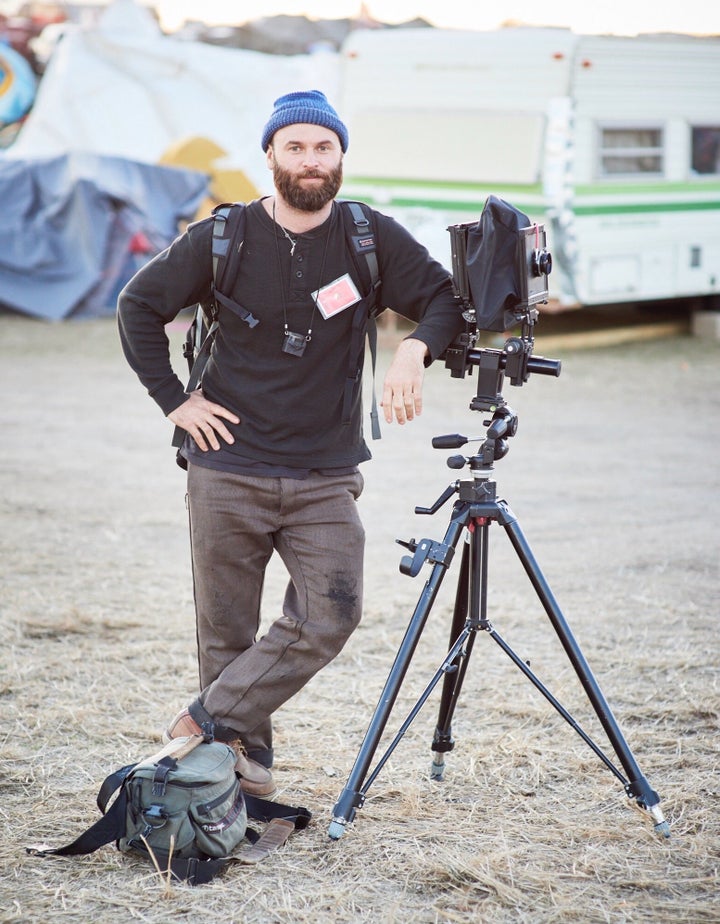
In late October and early November, Chris Callaway, a fashion photographer based in New York City, visited the Sioux Nation at Standing Rock Indian Reservation in North Dakota. He took portraits of the Native Americans protesting the planned construction of the Dakota Access Pipeline. He also recorded their voices.
Callaway says he went to Standing Rock because he wanted to create a more accurate representation of the protesters ― one that would go past the two-dimensional portrayals he was seeing in mainstream media coverage.
“When Natives talk, you can hear the intelligence and patience in their voices,” he said. “It reconnects you. It tears down those stereotypes a lot of us have built up.”
On Sunday, The Huffington Post spoke with Callaway, who was home for the holidays in Oklahoma, about his process.
What made you pivot from your usual work of fashion photography to photojournalism?
I think there are a lot of people ― I am one of them ― who would normally not be inspired to act out politically, but this year has been different. I saw the stuff that was happening at Standing Rock on the internet. And since I am from Oklahoma, and a little Native ― one-thirty-second Chickasaw ― I wanted to go to Standing Rock to do something.
Why use a still photograph with audio?
I feel like we’ve lost touch with what our Natives sound like. It’s important to hear regular people talk so that those stereotypes can be changed.
Why use a large-format camera?
Asking a Native for permission to take a photo is everything. It needs to be consensual. With the large-format camera, you have to talk to the person you are going to photograph before you take the photo, because the equipment is huge. It stands out like a sore thumb.
But it’s also a conversation starter. When I take the picture, it’s a dance. I have to throw the dark cloth over me. I have to pop my head out. I have to remove the film. I feel like people get a kick out of me doing the photo in the first place. I look kind of funny.
The large format forces me to spend time with the person. I get to know them a bit. And because of this, I get real honesty from people. I can look into their eyes and they relax. We have a relationship. They trust me.

“I feel like we’ve lost touch with what our Natives sound like. It’s important to hear regular people talk so that those stereotypes can be changed.”
- Chris Callaway, fashion photographer
Traditionally, black-and-white film is used with large-format cameras. Why did you use color instead?
To match the voice with the audio, it needed to be in color. I didn’t want to dumb down the situation. When I was there, it felt like a terrible contemporary version of “cowboys versus Indians.” And black and white, if I wasn’t careful, could bring it to that place.
This is 2016. Things are in color. That’s how we need to see it. It’s important to see the color of their skin. This is not a monochromatic situation. It’s very complex. So color it was.
What surprised you about being at Standing Rock?
I went out there for a protest. I went out there to give someone a voice. But I did not expect the level of spirituality that I encountered personally on this journey. Living in NYC, people say the best way to survive NYC is to leave NYC. But I didn’t think it would be on this level.
I’ve slowed down. I am trying to listen to people more, to let people finish their sentences, to look people in the eye. And with each person, I am trying to spend a little more time with them. I also felt there was a real connection with my ancestors, I guess. I felt like I wasn’t there alone. It sounds cheesy, but I really felt connected. I didn’t see that coming.
Anything you’d like to add?
The real story, for me, came from sitting around a campfire at night and talking to strangers and hearing people’s stories. There were so many kinds of people who came out to protest for different reasons: the environmental cause, or the civil rights one.
There were people from all over the world. But when everyone started talking to each other, I felt like there was something deeper connecting everybody. Stereotypes were being broken down on both sides, the Native and non-Native. And I think that’s what the world needs right now ― a unification that has nothing to do with skin color or where someone comes from.
Go Behind The Scenes With Other Reporters:
- Behind The True Crime Podcast Everyone Should Be Listening To Right Now
- A White Nationalist Changes His Mind
- The PTA Mom And The Power Couple From Hell
- How ‘Doonesbury’ Creator Saw Donald Trump’s Candidacy Coming A Mile Away
- This Is What It’s Like To Go Back to Rikers
- Typography Can Save Your Life
- You’ve Never Seen These Black History Photos Before
- A Glimpse Into The Syrian Refugee Crisis Through Virtual Reality
- Here’s Why College Costs So Much
- What It’s Like To Report From The Front Lines Of The Zika Virus
